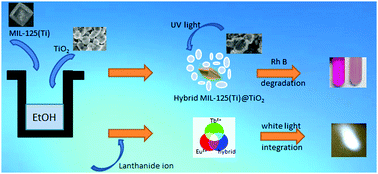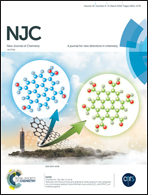Photofunctional hybrids of TiO2 and titanium metal–organic frameworks for dye degradation and lanthanide ion-tuned multi-color luminescence†
Abstract
Herein, a hybrid, MIL-125(Ti)@TiO2, has been synthesized. It is composed of TiO2 and titanium metal–organic frameworks and has been further utilized as a catalyst for dye degradation. The as-synthesized hybrid MIL-125(Ti)@TiO2 has a characteristic property of ultraviolet light absorption. The combination of MOFs and its corresponding metal oxides, and to be further employed as a ultraviolet light photocatalyst, is relatively unexplored. In this study, a titanium metal–organic framework and titanium dioxide are combined, and the results indicate that the hybrid MIL-125(Ti)@TiO2 has better performance of UV-light-driven RhB degradation in an aqueous solution as compared to pure TiO2. The hybrid also possesses excellent stability during the photocatalytic process. Furthermore, the luminescence properties of MIL-125(Ti)@TiO2 were investigated in detail after Ln3+ (Eu3+, Tb3+, and Sm3+) ions were doped into the hybrid. The emission spectra of Ln@MIL-125(Ti)@TiO2 show characteristic emission lines of the corresponding lanthanide ion when Ln@MIL-125(Ti)@TiO2 is exposed to a proper excitation wavelength. Moreover, a discussion of the tunable emission color of Ln@MIL-125(Ti)@TiO2 is included. This study illustrates that Ln@MIL-125(Ti)@TiO2 has the potential for white light emission application as it can emit white light upon change in the ratio of Ln3+ in the hybrid and the excitation wavelength.



 Please wait while we load your content...
Please wait while we load your content...